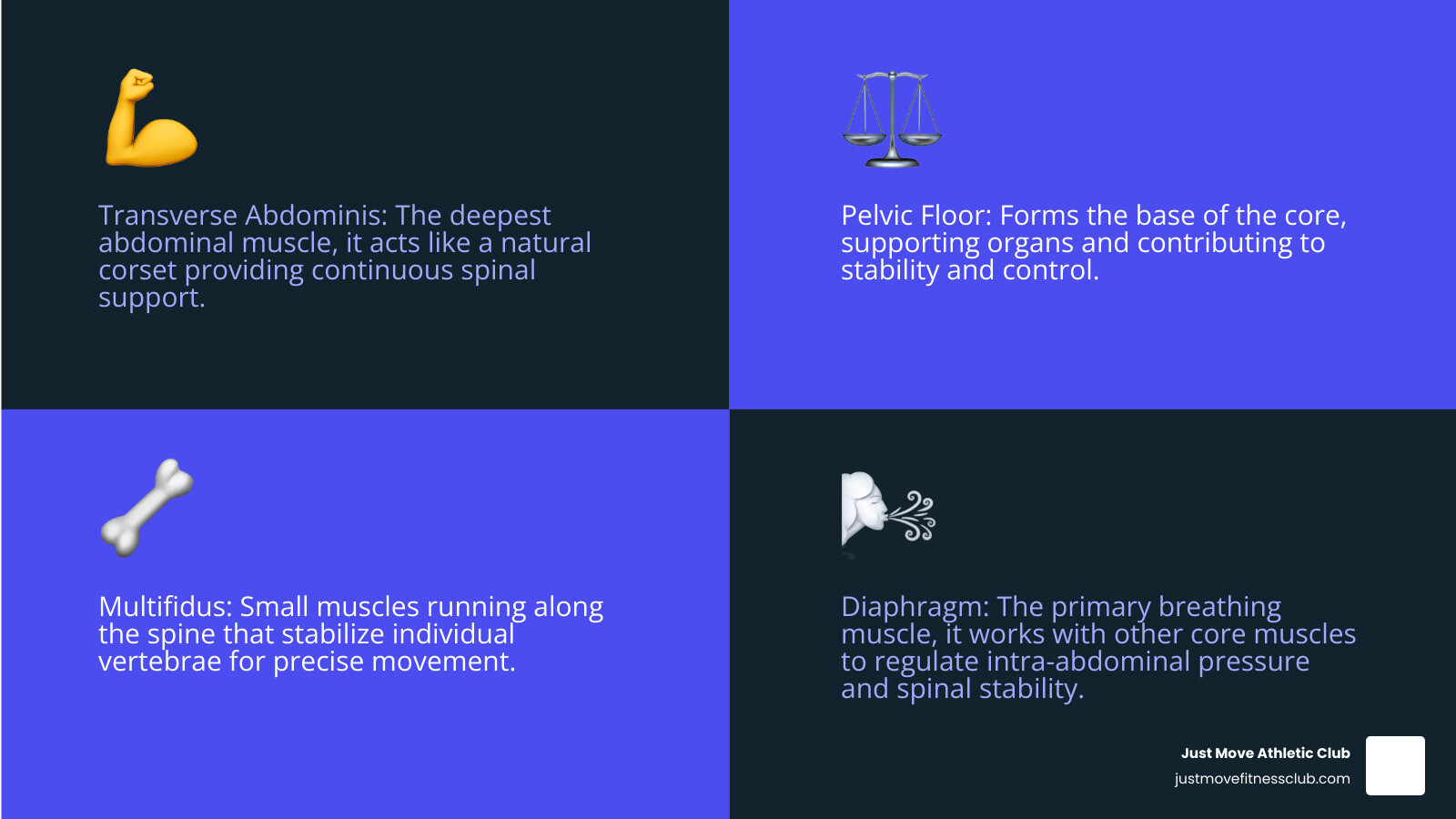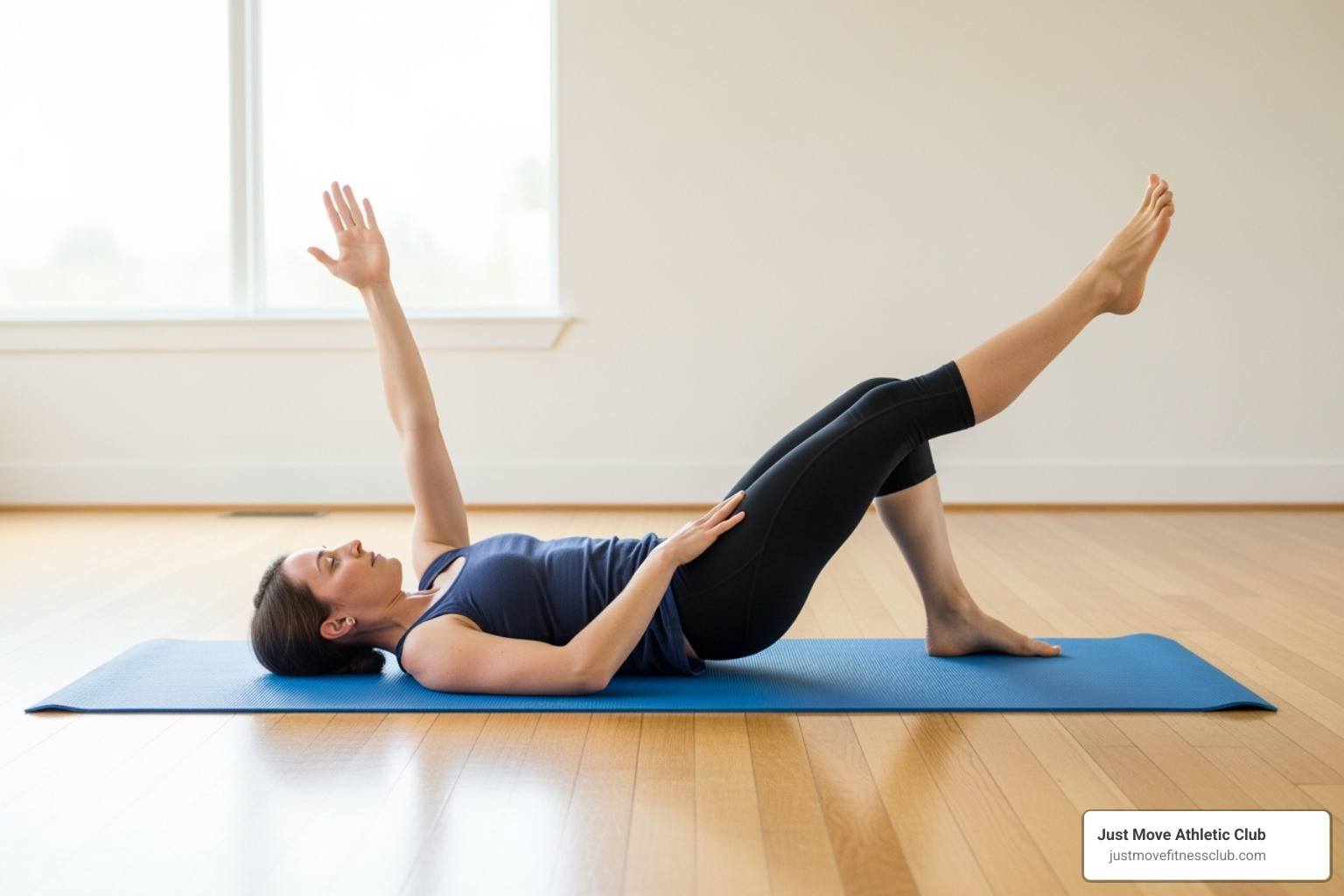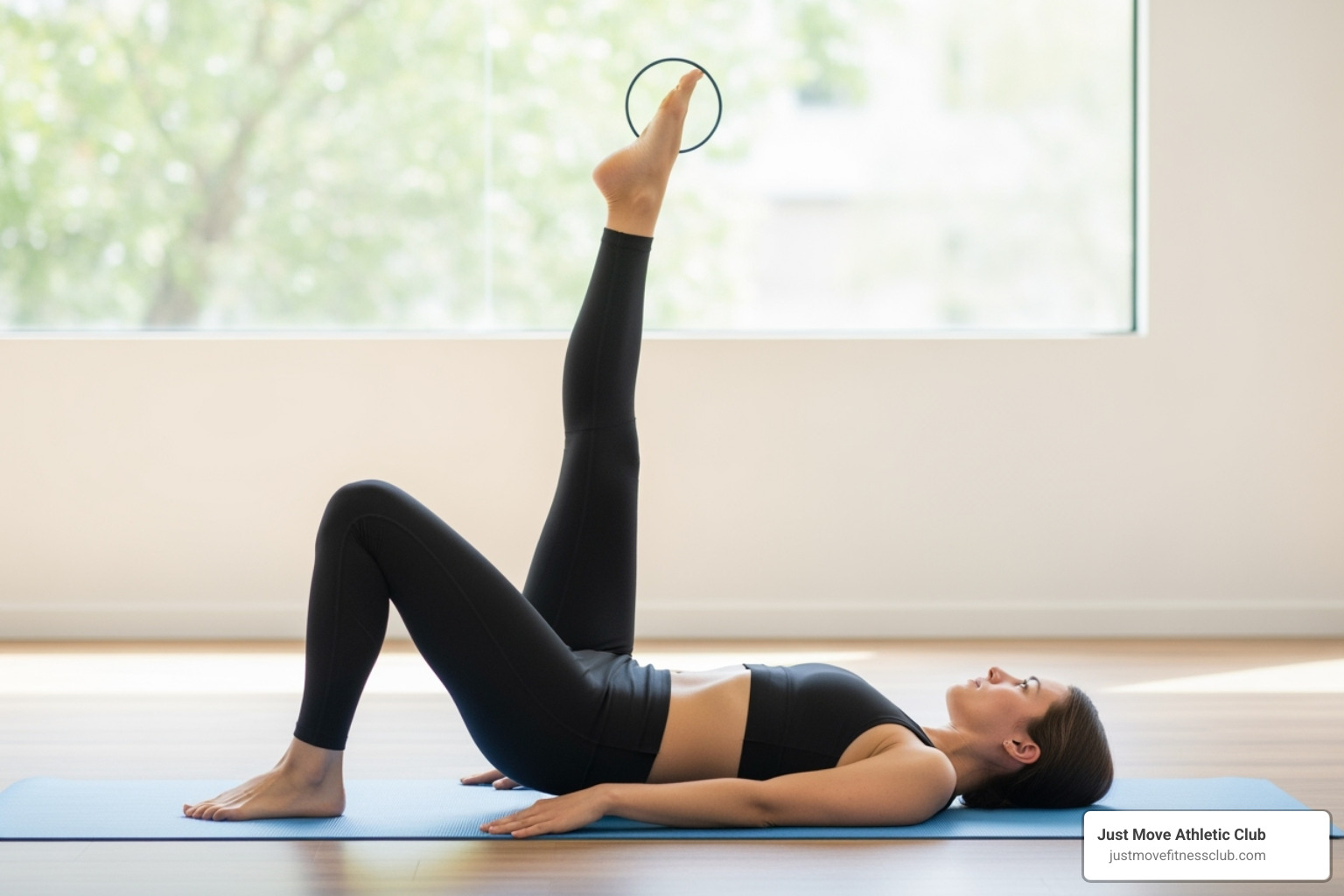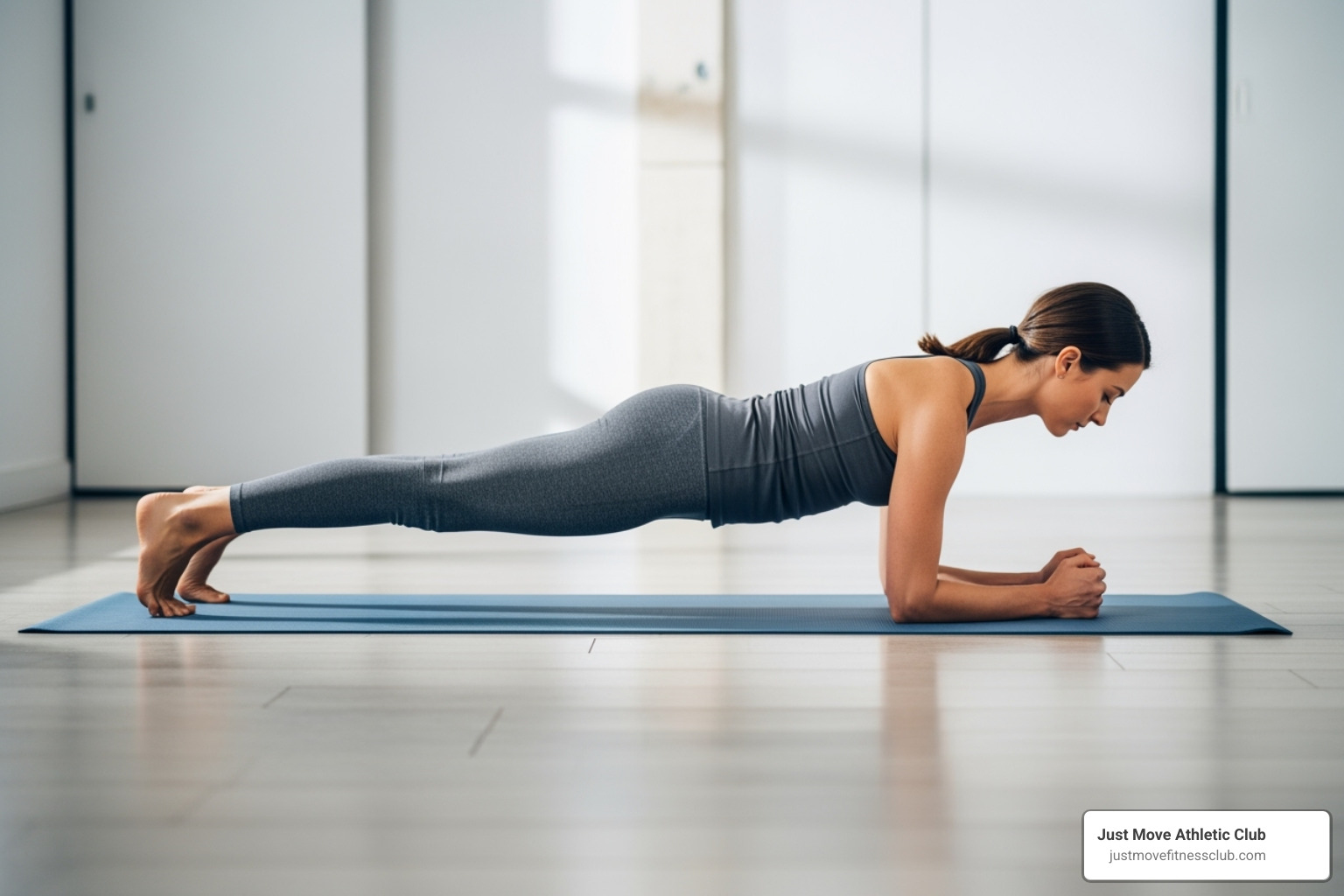Why Pilates for Core Stability is Essential for Your Health
Pilates for core stability is a highly effective way to build the deep, functional strength that supports your entire body. Unlike traditional ab workouts, Pilates targets the “powerhouse”—the deep stabilizing muscles that create true core strength from the inside out.
Quick Answer: The Best Pilates Exercises for Core Stability
- The Hundred – Builds core endurance and breath control
- Dead Bug – Improves spinal stability and coordination
- Single Leg Circles – Develops pelvic stability and hip mobility
- Plank – Creates full-body engagement and deep core strength
- Rolling Like a Ball – Improves spinal articulation and balance
Research shows that Pilates strengthens core muscles like the transverse abdominis, multifidus, and pelvic floor, which are crucial for spinal stability and preventing lower back pain. These deep muscles provide continuous support for your spine by contracting at just 25-30% of their max strength.
The core benefits include:
- Reduced lower back pain and improved posture
- Better balance and decreased fall risk
- Improved stability for daily activities
- Improved athletic performance and injury prevention
With decades of experience in the fitness industry, experts have seen Pilates for core stability transform people’s strength and confidence. Pilates programs help people of all fitness levels build a strong foundation for lifelong health.

Understanding the ‘Powerhouse’: What is Core Stability in Pilates?
If you’ve wondered why Pilates for core stability feels different from regular ab workouts, the answer lies in the “powerhouse.” Coined by Joseph Pilates, this term refers to the network of muscles that wraps around your trunk like a natural corset, creating a center of strength.
The powerhouse isn’t just your abs; it extends from your rib cage to your buttocks, including your deep abdominal muscles, lower back, hips, glutes, and pelvic floor. These muscles work together to create a stable foundation for every movement.
Your core has two muscle systems: the deep core team and the surface muscle team.
The deep core muscles are your body’s stabilizers. The transverse abdominis acts like an internal belt, the multifidus muscles support your spine vertebra by vertebra, the pelvic floor creates a supportive base, and the diaphragm coordinates breathing with stability.
These deep muscles work at just 25-30% of their maximum strength to provide constant support. Research shows the transverse abdominis activates before you even move, anticipating the need to protect your spine.
Your superficial muscles, like the rectus abdominis (“six-pack” muscles) and external obliques, handle bigger movements and heavier loads. They’re important, but they need the deep core’s support to function correctly.
Pilates for core stability is a game-changer because it trains your deep stabilizers first, building a solid foundation. When your powerhouse is strong, your posture improves, daily activities become easier, and athletic performance gets a boost. The Pilates method teaches these muscles to work together automatically, making a strong core the foundation for all movement.
Why Pilates for Core Stability is a Game-Changer
What makes Pilates for core stability so effective is its blend of mind and body. Pilates emphasizes slow, controlled, and precise movements. This mindful approach targets the deep stabilizing muscles that support you all day, not just the surface muscles you see in the mirror.
Pilates is also gentle on your joints, making it suitable for all ages and fitness levels, including those recovering from injury or dealing with chronic pain. The focus on proper alignment builds a body that moves efficiently and without pain.
Here’s how Pilates for core stability compares to traditional ab exercises:
| Feature | Traditional Ab Exercises (e.g., Crunches) | Pilates Core Work |
|---|---|---|
| Primary Muscle Focus | Superficial muscles (rectus abdominis, obliques) | Deep intrinsic muscles (transversus abdominis, pelvic floor, multifidus) and integrated global muscles |
| Movement Quality | Often fast, repetitive, can involve momentum | Slow, controlled, precise, mindful |
| Spinal Health | Can sometimes strain neck or lower back if form is poor | Emphasizes neutral spine, articulation, and spinal protection |
| Functional Strength | Builds strength for specific movements | Builds integrated strength for everyday activities and complex movements |
| Mind-Body Connection | Less emphasis on conscious muscle engagement | High emphasis on concentration, and body awareness |
| Injury Prevention | Limited, can sometimes contribute to imbalances | Strong focus on correcting imbalances, improving posture, and protecting joints |
| Overall Benefits | Strength, muscle definition | Stability, balance, flexibility, posture, pain reduction, body control |
The Crucial Role of Breathwork
In Pilates, how you breathe is as important as how you move. We teach diaphragmatic breathing, or lateral rib cage breathing. As you inhale, your rib cage expands to the sides; as you exhale, it gently draws together. This technique is highly effective for core engagement.
The magic happens on the exhale. Breathing out during the challenging part of an exercise naturally activates your transversus abdominis, creating intra-abdominal pressure. This acts as your body’s internal stability system. Research confirms that Pilates breathing increases the activity of deep abdominal muscles, delivering measurable results.
Key Benefits of Pilates for Core Stability
Consistent Pilates for core stability practice brings benefits that extend beyond your workout.
- Improved posture: Strong deep core muscles naturally pull you into better alignment, reducing neck and shoulder tension.
- Reduced lower back pain: Your core acts as a natural back brace, taking the strain off your lower back. A scientific review on Pilates for chronic low back pain confirms its effectiveness.
- Better balance and coordination: A strong, stable center allows the rest of your body to move more freely and confidently.
- Decreased risk of injury: A stable core protects your spine and joints during daily activities and sports. The increased body awareness you gain helps you move more safely.
Signs of a Weak Core and How Pilates Can Help
A weak core can be the hidden cause of various issues. Here are some common signs:
- Chronic lower back aches: When your core is weak, other muscles overcompensate, leading to a sore, tired back.
- Poor posture: If you constantly slouch, your core muscles likely aren’t providing adequate support.
- Instability and fatigue: Feeling wobbly during simple tasks or tiring easily during physical activity can indicate a weak core.
A simple test: can you hold a proper plank for 30 seconds without your back sagging? If not, your deep core muscles may need strengthening. Pilates addresses these issues by retraining your muscles to work together efficiently through precise movements and focused breathwork.
5 Foundational Pilates Exercises for a Rock-Solid Core
These five foundational exercises will help you experience the benefits of Pilates for core stability. In Pilates, always prioritize quality over quantity. Focus on proper form, listen to your body, and start with modifications. Strength and control will improve with consistent practice.
1. The Hundred

The Hundred is a classic exercise that builds core endurance, improves breath control, and boosts circulation. It’s a perfect way to warm up your powerhouse.
How to do it:
Lie on your back with knees bent to a tabletop position (shins parallel to the floor). Exhale as you lift your head, neck, and shoulders off the mat, creating a C-curve in your upper spine. Extend your arms alongside your body, palms down. Begin pumping your arms up and down in small, controlled movements. Inhale for five pumps and exhale for five pumps. Repeat ten times to complete 100 pumps.
- Beginner modification: Keep your head on the mat and feet on the floor.
- Progression: Straighten your legs and lower them toward the floor, keeping your lower back pressed into the mat.
2. Dead Bug

The Dead Bug is highly effective for teaching lumbopelvic stability, core control, and coordination. It trains your spine to remain stable while your limbs move.
How to do it:
Lie on your back with your legs in a tabletop position and arms extended toward the ceiling. Engage your core, gently pressing your lower back into the mat. Exhale as you slowly lower your right arm and left leg toward the floor, keeping your core tight to prevent your back from arching. Inhale as you return to the start. Switch sides and repeat, moving slowly and with control.
- Beginner modification: Move only one limb at a time or reduce your range of motion.
- Progression: Add light weights or resistance bands.
For a visual guide, check out this Dead Bug tutorial.
3. Single Leg Circles

Single Leg Circles challenge your pelvic stability while improving hip mobility. The goal is to move your leg freely while keeping your pelvis completely still.
How to do it:
Lie on your back and extend one leg toward the ceiling (keep a slight bend if needed). Engage your core to keep your pelvis stable and level. Begin drawing small circles on the ceiling with your extended foot, moving only from the hip joint. Complete 5-8 circles in one direction, then reverse. Switch legs and repeat.
- Beginner modification: Make smaller circles and bend the knee of the working leg.
- Progression: Make larger circles or add a point-and-flex foot movement.
4. Plank

The Plank is a full-body exercise that builds deep core strength and shoulder stability, challenging your body to work as one unit.
How to do it:
Place your forearms on the mat with elbows under your shoulders. Extend your legs back to create a straight line from your head to your heels. Engage your core by drawing your navel toward your spine, and squeeze your glutes. Avoid letting your hips sag or hike up. Keep your neck in line with your spine by looking at the floor. Hold for 30-60 seconds with perfect form.
- Beginner modification: Perform the plank on your knees, maintaining a straight line from head to knees.
- Progression: Try lifting one leg at a time or moving from plank to a pike position.
5. Rolling Like a Ball

This exercise challenges your abdominal control and spinal articulation while improving balance. It’s like a massage for your spine.
How to do it:
Sit on your mat, grab your ankles or shins, and draw your knees to your chest. Round your back into a “C” curve, tuck your chin, and lift your feet to balance on your sit bones. Inhale as you roll back to your shoulder blades (not your neck). Exhale and use your core—not momentum—to roll back up to the starting position without your feet touching the floor. Repeat for 6-10 smooth repetitions.
- Beginner modification: Place hands behind your thighs and practice balancing in the ball shape without rolling.
- Progression: Hold your ankles and focus on maintaining a perfect C-curve with minimal momentum.
Frequently Asked Questions about Pilates for Core Stability
Here are answers to some common questions about using Pilates for core stability.
How often should I do Pilates to strengthen my core?
Consistency is more important than intensity. For most people, 2-3 sessions per week is the ideal frequency to build core strength while allowing for muscle recovery. Even short, 15-minute sessions can make a difference. Pilates is also a great complement to other activities like running or weightlifting, making it perfect for active recovery days.
Can I do Pilates for core stability if I have back pain?
Yes, Pilates can be incredibly helpful for back pain, but it’s crucial to talk to your doctor or physical therapist first. Once you are cleared for exercise, working with a qualified instructor is essential. They can provide modifications to keep you safe while you build strength. Pilates focuses on neutral spine positioning and controlled movements to protect your back. Always stop if you feel pain—there is always a modification that will work for you.
Do I need special equipment for Pilates core exercises?
No, you don’t need special equipment to see results. Mat Pilates is highly effective and can be done anywhere with a good quality mat for cushioning. As you progress, simple props like a Pilates ring or a small exercise ball can add variety and challenge. Many Pilates studios provide all the necessary equipment during classes, allowing you to try different props and receive expert guidance.
Conclusion: Build a Stronger Foundation Today
Your exploration of Pilates for core stability shows that true strength is built from the inside out. By strengthening your “powerhouse,” you create a foundation for every movement, leading to better posture, less back pain, and improved balance and confidence.
Pilates is a gentle, sustainable practice that grows with you. It’s not a quick fix but a method for building functional strength that serves you for life, whether you’re 25 or 75. It teaches you to move with intention and control.
Countless people have transformed their bodies and found new confidence through Pilates. Experienced instructors can guide you on your journey, helping you find what your body is capable of in a supportive environment.
Finding a local class or studio can provide the space and expertise you need to build a stronger foundation. Don’t wait to give your core the attention it deserves. Start building a stronger, more confident you today.
